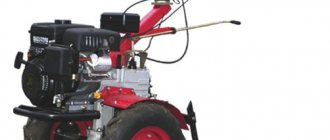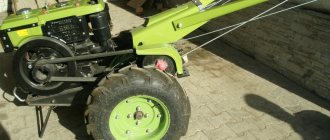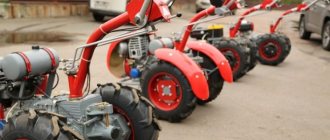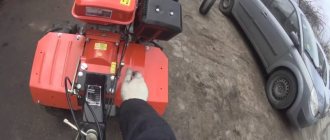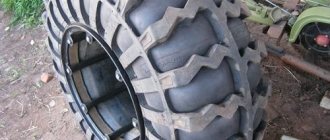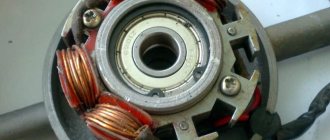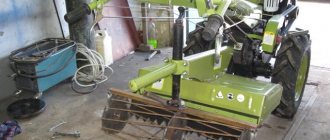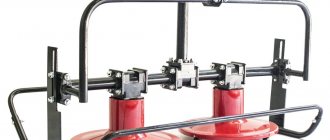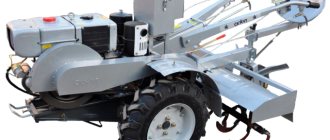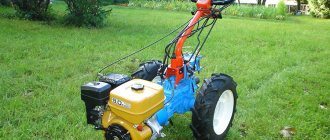As you know, agriculture has received many interesting and, most importantly, useful technologies in recent years. These technologies are constantly being improved, which of course allows the farmer to always make the best choice, but the sheer variety of technologies often confuses the average unprepared consumer.
Today we will tell you how to decide on the choice of a walk-behind tractor, what models are on the market, and why you should choose walk-behind tractors with a low gear compared to conventional ones. You will learn about the advantages and differences between conventional walk-behind tractors and devices with low gears from our article.
What kind of oil to pour into the gearbox of a walk-behind tractor - choose the product
The choice of lubricant for the gearbox of an existing walk-behind tractor depends on several factors.
First of all, this includes the recommendations of the manufacturer of the agricultural machinery used. The second, no less important feature is the cost of the purchased oil. Directly in the store, special attention should be paid to the viscosity of the oil - as a rule, this parameter is indicated on the can of the material. Also, if necessary, you can always purchase special additives in the store that can significantly improve the properties of the selected lubricant.
In practice, gear oil is considered the most optimal means for lubricating the gearbox. This composition is able to prevent various breakdowns of the mechanism and protect its rubbing parts when working in difficult conditions. Transmission oils of the ZIC 10W40 brand are considered one of the leaders in the domestic market - this semi-synthetic material covers the gearbox parts with a thin film and protects them from wear.
Changing the oil in a walk-behind tractor - how to do it yourself?
Immediately before performing the procedure, the walk-behind tractor gearbox will need to be cleaned of old lubricant. This is not difficult to do - in some cases it will be necessary to disassemble and dismantle certain parts of the walk-behind tractor, however, most units have free access to the gearbox drain cover.
The procedure for changing the oil is as follows:
- To begin with, the existing walk-behind tractor will need to be installed on any elevation - this will make it much easier to drain the oil from the gearbox. If necessary, bricks can be placed under the wheels of the unit;
- There is a drain plug at the bottom of the gearbox, and a filler plug at the top. First you need to unscrew the filler plug, then place a wide container under the drain plug;
- Next, you need to start carefully unscrewing the drain plug. As soon as oil begins to flow out of it, the plug must be completely unscrewed and wait until all the lubricant has drained out;
- After this, you need to tighten the drain plug, insert a funnel into the filler hole and fill in new oil;
- Having filled in the required amount of oil, you need to screw the filler plug back in. On its lower side there is a special dipstick, about 10 cm long - it is designed to check the oil level. If the poured lubricant reaches the tip of the dipstick, then adding oil is no longer required. The video will tell you more about the sequence of changing the oil in the gearbox of a household walk-behind tractor.
https://youtube.com/watch?v=_2LY1uXDlfw
If the agricultural implement is used extremely intensively, then this procedure will need to be performed every 50 hours of work done. In all other cases, a one-time replacement of the product for every 100 hours of operation of the unit is sufficient.
How much oil to fill in the gearbox of a walk-behind tractor?
Immediately before pouring new oil, you need to find out how much old material is poured into the gearbox.
This is done in this order:
- First, the walk-behind tractor is placed on a flat surface;
- Next, take a metal wire, at least 70 cm long, and bend it into an arc;
- The resulting product must be pulled through the existing filler hole and pushed all the way through. As soon as the wire touches the bottom of the gearbox, it should be pulled back.
After this, you need to calculate the length of the wire coated with oil. If the product is approximately 30 cm deep in the lubricant, then this is considered the optimal amount of oil that needs to be poured into the gearbox when replacing. If the homemade sciat turned out to be completely dry, then you will need to pour at least 2 liters of previously unused transmission lubricant into the walk-behind tractor gearbox.
Reviews on the technical characteristics of the OKA MB-1D2M9 walk-behind tractor
The Oka walk-behind tractor with a differential, the brand of which was mentioned in the subtitle, has, according to buyers, an affordable price of 38,500 rubles. The power of the unit is 6.5 liters. s., and the number of speeds is only four. Two for moving forward and two for moving backward.
The plowing width can vary from 72 to 113 cm, and the plowing depth is 30 cm. This value, as customers mention, can be achieved only in a few passes. The equipment has a mechanical two-speed chain gearbox, and the volume of gearbox oil varies from 1.5 to 2 liters. The package includes:
- walk-behind tractor;
- pneumatic wheels;
- 4 cutters for loosening the soil;
- opener
Parts, assembly of new units and complete set of walk-behind tractor
Unfortunately, not many parts can be used from an old VAZ for a walk-behind tractor. Here is a list of what will be useful in one case or another:
- engine, since the Zhiguli has a gasoline engine, this option is not the most economical;
- fuel tank and fuel system parts;
- exhaust gas removal system;
- air filter;
- starter;
- steering wheel, gas and clutch levers;
- gearbox, transfer case;
- wheels;
- rear axle - useful for assembling a trailer structure.
In fact, this is everything that can be used from VAZ. It is very difficult to make a homemade walk-behind tractor from a Zhiguli bridge and similar VAZ models without many transformations, so you have to use only individual parts of the chassis.
Usually the engine for a walk-behind tractor is a diesel one, so it’s worth delving into old motorcycle equipment, for example, the same motorcycle. There are some homemade products with saw motors, but they are used for light earthworks.
The choice of engine is very important, so focus on the type of work that will be performed by the walk-behind tractor. For medium loads with plowing the land and harvesting crops, a motorcycle engine is sufficient, but for more labor-intensive work, a car engine will be required.
In some cases, if there are not enough parts, you can buy original spare parts for walk-behind tractors and use them in the design. This option should be considered only if the drawing contains recommendations and examples for converting purchased spare parts.
Since we need to get a working prototype, try to follow all instructions as closely as possible and carry out all work according to the diagram and drawings.
How to assemble a walk-behind tractor yourself
Let's look at how to assemble a walk-behind tractor with your own hands. Parts that can be used for DIY are taken from old motorcycles and scrap metal. As an engine, which is often installed on homemade motor cultivators, you can use a motor from Druzhba - a chainsaw.
This engine has sufficient power to allow the use of various attachments. This significantly expands the functional use of motor cultivators. Many people install the engine from the Ant scooter on their walk-behind tractor, which has excellent characteristics and parameters for working in their summer cottage.
To create a walk-behind tractor at home, you will need the following spare parts and materials:
- Steel corners measuring 36x36 mm or pipes 60x50x2 mm. From these parts you can assemble a frame for a walk-behind tractor.
- Engine fully assembled.
- Fuel tank.
- Exhaust system.
- Air filter.
- Kickstarter.
- The steering wheel on which the clutch and gas handles should stand.
The following tools will help you make a walk-behind tractor with your own hands:
- Welding machine.
- Drill.
- Vise.
- A set of horns and spanners.
- A grinding machine on which a special disk must be installed for cutting metal.
How to make a homemade walk-behind tractor based on a ZAZ gearbox
The gearbox for a walk-behind tractor converts a high rotation speed on the input shaft to a low speed on the output shaft. Regular maintenance and timely repairs will allow you to successfully operate the walk-behind tractor gearbox and avoid sudden breakdowns.
Of course, it is best if you understand the principles of operation of the walk-behind tractor and know the structure of its gearbox. Every farmer who knows the design of the gearbox of his walk-behind tractor will be able to correctly diagnose and repair it. In severe cases, of course, you need to contact specialists with relevant experience.
If a stepwise change in the rotation speed of its output shaft is sufficient for a walk-behind tractor gearbox, then a car gearbox can be used instead in home-made walk-behind tractors. A good option may be a homemade walk-behind tractor based on the ZAZ gearbox. Below is an example of the design of such a walk-behind tractor for household farming. According to the owner, it took about one month to make it.
The first tests showed its low weight, after which weights were added to the wheels and the front counterweight. The weight of the walk-behind tractor turned out to be about 160 kg.
Motoblock capabilities: plows, cultivates, hills, digs; milling; transports loads up to 800 kg.
Axle shafts of a homemade walk-behind tractor based on the ZAZ gearbox
The manufacture of an axle shaft is fraught with numerous nuances. In order to understand how to make a homemade walk-behind tractor with a ZAZ gearbox, it is advisable to increase the level of your knowledge and become familiar with technical literature.
Good knowledge will allow you to make a homemade walk-behind tractor, which you can either operate yourself or sell to your friends. This way you will have a unit that perfectly suits your requirements. At the same time, you will save significant money.
In order to make homemade tractors and walk-behind tractors, you need physical strength and time. With enough experience, you can learn how to make reliable universal-purpose agricultural machines. It’s also a good idea to master making homemade hitches for walk-behind tractors and additional attachments.
If you are faced with a choice: buy or independently make a homemade walk-behind tractor with a ZID engine and a gearbox for a ZAZ gearbox, then it is better to choose the second option. Study special literature in advance, develop drawings, scour the Internet - and you can successfully make an effective agricultural unit.
Homemade tools for walk-behind tractors are necessary in many cases, because they allow the equipment to become more functional. To securely attach them, it is advisable to use homemade hitches to the walk-behind tractor, which are of high quality and designed taking into account the characteristics of mounted implements.
Regular or reduced?
How does low-speed gearbox technology differ from classic gearbox technology? First of all, the fact that in order to switch the transmission speed it is necessary to directly perform it. This creates a short-term cessation of rotation in principle, while the lowered gearbox works to create a kind of “reserve” of speeds, which allows not only a soft start, which will make the work safer, but also switching gears directly during operating time, without interference.
And a vehicle with a reduced gearbox moves much faster (on average by 45%) than its analogues that lack this function. Accordingly, a low-range gearbox is safer, faster and smoother.
Assembling a walk-behind tractor from scratch
If you are going to construct an entire walk-behind tractor with your own hands, or even an entire mini-tractor, before starting work you should think about the feasibility of implementing such a project. The modern market can offer the user many models of domestic and Chinese-made walk-behind tractors, whose characteristics allow for work of low and medium difficulty. Moreover, the price of such equipment is quite affordable for many users. So the project to create your own walk-behind tractor should have the following advantages:
- low cost;
- the possibility of using old spare parts from equipment, cars or motorcycles when assembling;
- improved performance compared to the factory equivalent;
- additional functionality.
The project is worth implementing if at least 3 of the listed points have been met. Otherwise, the idea is not worth the cost and it is easier to buy a ready-made walk-behind tractor, even a used one, with subsequent updating of parts.
Now about the design. You need to find a drawing according to which the homemade product will be assembled. The drawing will indicate the main parts, features of their installation, as well as the method of manufacturing fasteners for spare parts. Without documentation, it will be impossible to implement the project, so the primary task is to find the most suitable drawing. After this, you can begin selecting materials.
This is interesting: The best Russian and Chinese walk-behind tractors with a power take-off shaft - all the nuances
Walk-behind tractor with differential: the best models and reviews about them
Those summer residents who are seriously engaged in vegetable gardening know that when carrying out certain work they cannot do without special equipment, because it will not be possible to cultivate the land by hand. Otherwise, you will spend a lot of effort and time, and this will not improve your health.
That is why quite often people think about how they can make their work easier, what equipment can be used for this, what characteristics it should have, and what its cost should be. It’s worth thinking about these questions even before going to the store, because otherwise you may buy equipment that will not live up to your expectations.
Additional accessories
Walk-behind tractors are sold with a minimum number of components. However, a milling cutter and a standard plow are not enough to perform all agricultural work. How to improve a motor cultivator using scrap materials? With the help of tools that are found in every home, you can expand the capabilities of the walk-behind tractor. Equipment that you can make yourself:
- Installation of a rake on a walk-behind tractor for collecting debris, leaves, and hay. Such a simple device will speed up autumn field work and allow you to clear large areas of debris in a matter of minutes. To make a rake you will need: several meters of reinforcement with a cross section of 8-12 mm and a strip of sheet metal. The reinforcement is cut into pieces 10 cm long and welded to the plate in several rows with an interval of 3-5 cm. To increase maneuverability, the rake can be equipped with roller wheels.
- A trailer and cart will help transport large loads. The cart can be made from scrap materials - channel and old car wheels, metal profiles and boards. The clutch is made standard for both tractors and cars.
- If desired, you can make a potato digger, hiller and harrows, which will not be inferior in quality to purchased ones.
Plows for walk-behind tractors
Another device for cultivating soil using a walk-behind tractor is a plow. The following types of plows are distinguished:
- The easiest to use is the single-hull one, also known as the Zykov plow.
- Reversible plow for walk-behind tractor: rotary or reversible. The upper part has a curved feather, which turns the soil over during plowing. A universal device that easily copes with plowing heavy soils. Quickly copes with the treatment of areas with clay and marshy soil.
- The rotary plow for a walk-behind tractor has a complex design. Depending on the number of ploughshares, there are two-body and three-body models. Active plowshares dump soil in one direction only, while passive plowshares level the beds and lift them. Tilling the soil with such a plow has a number of advantages: the soil is maximally saturated with oxygen; tire wear and fuel consumption are reduced; after processing there are no large clods of earth left.
- A rotary plow for a walk-behind tractor provides unlimited possibilities. During operation, the axis rotates, and with it the soil layers. It easily plows even very hard soil at a depth of about 30 centimeters. There are paddle, drum, shovel and auger plows. Devices of the first type are equipped with a rigid pusher and can consist of a spring plate or be combined. Units of the second type are equipped with a disk with blades that rotate during operation. A plow with a disc blade for a walk-behind tractor is suitable for work in early spring; it copes well with wet soil.
Reviews about the main advantages of the model
The above-described heavy walk-behind tractor with a differential, according to buyers, has many positive features, including:
- comfortable control;
- reliable power plant;
- excellent maneuverability;
- efficiency.
Comfort is provided by the handle, which can be adjusted. But reliability is guaranteed by a diesel engine, which can easily handle soil cultivation with any characteristics. You can work with this walk-behind tractor even on virgin soil.
The unit has good cross-country ability, which is ensured by large wheels and tires with an aggressive tread pattern. The presence of a plow allows you to cut and turn the top layer of dense soil. Such walk-behind tractors with a PTO and a differential are quite common today. Consumers choose them because of their water cooling, plow included as standard, and low noise levels.
The engine life, as buyers mention, is quite large and reaches 3100 hours. Engine starting is made easier by a decompressor. In an hour of soil cultivation, you can cover a width of 105 cm. For a stable position of the unit, the manufacturer has provided a special stop, so the unit feels confident in a stationary state.
Creeper
The traction of the wheels of a tillage machine with the soil can be enhanced if you use lugs or a creeper for a walk-behind tractor. The creeper is one of the mounted devices. It makes it possible to reduce the speed of the agricultural unit and increase traction force along with torque. An analogue of a gearbox operates using a chain and sprockets on the shafts. If desired, this device can be made by hand. Parts are used from other equipment.
Each considered converter has its own disadvantages. To reduce their number to a minimum, you should try to make the device yourself. A homemade item can be of higher quality and easier to use than a purchased item.
What attachments are available for the walk-behind tractor?
The most common types of attachments for walk-behind tractors:
- plow for walk-behind tractor
; - trailer;
- hiller;
- cultivator;
- seat adapter;
- lugs;
- hitch
Interesting materials:
How to open the drum of an Indesit washing machine? How to open the drum of an Indesit washing machine? How to open the drum of a Hotpoint Ariston washing machine? How to open the door of a Candy washing machine? How to open the washing machine door if it does not open? How to open the door of an Indesit washing machine? How to open the door of a Samsung washing machine during washing? How to open the door of a Samsung washing machine? How to open the door on a Bosch washing machine? How to open the filter on an Indesit washing machine?
Homemade design
You can make a gearbox for a walk-behind tractor with your own hands. Before starting work, it is necessary to take into account the engine speed and calculate the maximum load on the mechanism shafts.
Without determining these parameters, the assembled gearbox will not meet the specified power and will quickly fail. Here's what the build process looks like.
We make the body. To do this, you can borrow a finished product from a motorcycle. If you don’t have a motorcycle at hand, you can weld the body yourself from sheet metal. Gears can be removed from the Friendship 4 chainsaw or you can also make them yourself
When making gears yourself, you need to take into account the diameter of the gearbox housing. Therefore, the size of the gears is determined using a caliper. To operate the mechanism you will need two gear shafts
These elements can be removed ready-made from the Ural motorcycle and installed in the walk-behind tractor gearbox after minor modifications. At the first shaft, you need to shorten the end cap and drill a hole in the housing. The second shaft is installed on the opposite side of the housing, where you first need to cut a hole of a suitable diameter. The hole must be supplemented with a flange, which is attached to the body using threaded connections. We install a steel washer and a ball bearing inside the flange. We connect the shafts to each other using a transmission mechanism. We supplement the output end of the shaft with a pulley, which will serve to install a belt drive.
After these manipulations, you will get an angle-type gearbox.
Reviews about the features of the FERMER FM-1309MD walk-behind tractor
This device is multifunctional and designed to treat all types of soil. The equipment has control levers on the steering wheel and a differential built into the gearbox. A walk-behind tractor with a gasoline engine weighs 175 kg and has an engine capacity of 389 cm3. The volume of the fuel tank, according to buyers, is quite impressive and amounts to 6.5 liters. The cultivation width reaches 1350 cm. The differential system allows you to make turns and turns using only one handle, which is conveniently located on the steering wheel of the walk-behind tractor.
Additional advantages include wheels of impressive diameter, which allow for increased maneuverability. Consumers especially note the presence of a universal hitch and a distance between the wheels of 60 cm. The package includes the walk-behind tractor itself, rubber wheels, a milling cutter and instructions in Russian, which will help you understand the functionality. The engine power is quite high and amounts to 13 liters. With. or 9.6 kW. The device is powered by a four-stroke engine, and the maximum processing depth varies from 150 to 300 mm.
Homemade mini tractors, all-terrain vehicles and cars
DIY cars, all-terrain vehicles, tractors and walk-behind tractors
Blueprints
We will also highlight drawings as a separate item. We recommend that you take a careful look at them before you begin. The instruction manual for any mini walk-behind tractor is suitable for this. The Gardenshop store has collected for you the necessary drawings for assembling a walk-behind tractor with your own hands.
READ Motoblock Kutaisi Super 610 Engine Replacement
Assembling a walk-behind tractor from a chainsaw
If you have an unnecessary saw lying around in the garage somewhere, then you can easily convert it into a motor cultivator. Here you can't do without understanding the drawings. A drawing for a walk-behind tractor made from a chainsaw is necessary primarily in order to be able to maintain the highest accuracy during installation.
Recommendation: It is better to use a powerful, compact and lightweight chainsaw with high performance to create a motor cultivator.
- Creating a frame. It needs to be made into a cubic shape with corners measuring 32 x 32 cm.
- Engine installation. It should be attached to the cross member of the frame.
- Install the fuel tank. It is installed under the cross member of the frame. It is best to use brackets to implement this point.
- Weld the bearings onto the supports.
- Creation of steering control. Weld the center of gravity, which is located above the wheelbase, to the wheel support. Any engine ignition switch will work.
The advantages are obvious: there are no serious requirements for lubrication and fuel, it works autonomously, and can be used in hard-to-reach places. In addition, such a homemade cultivator made from improvised materials is very compact and lightweight.
Assembling a walk-behind tractor from a car
Absolutely any car is suitable for this. What tools will you need?
- checkpoint
- Final drives
- Front suspension
- Steering rack
- Wheels
At the very beginning of the assembly, you need to weld a strong metal pipe up to 10 cm in size to create an axis. On both sides of the end of the pipe, you need to weld ball bearings to the body, then attach motorcycle wheels to them. You need to attach a gearbox from the same motorcycle to the pipe by welding brackets. After carrying out such a cycle of work, it is possible to install a full-fledged engine on the basis of the ZAZ gearbox. The last step will be to attach the unit control handles to the vertical holder.
Reviews of the UGRA NMB-1N9 walk-behind tractor
Motoblocks with the Ugra differential are very popular among consumers. This is due to the not so high cost, which is equal to 54,000 rubles. The equipment is equipped with a metal tank, a reduction gear, and the ground clearance is 170 cm.
The maximum speed, according to buyers, is quite high. In first gear you can move at a speed of 3.61 km/h, in this case we are talking about pneumatic wheels, while if you install lugs, the speed will be reduced to 3.5 km/h. In third gear, the walk-behind tractor increases speed to 8.52 km/h on pneumatic wheels and to 8.25 km/h on lug wheels.
The power of the equipment is 6 liters. s., and the fuel tank holds 3.6 liters. The transmission is represented by a manual gearbox, as well as a gear reducer. The equipment does not weigh that much, which is what buyers like, the device weighs only 85 kg.
Build process
It will be better to start making a homemade gearbox by installing the drive sprocket of the first stage of the gearbox on the output shaft. The star can be attached in different ways, in each design individually. Can be fixed with a key, flange, or spot welding. The driven shaft is assembled using 2 axle shafts. Their ends require counter flanges. Between the flanges, you need to install the 2nd stage driven sprocket in its place, after which you can assemble the axle shafts into a whole structure using a bolt connection.
To organize the protection of the chain transmission, the 2nd stage gear unit is protected with a protective housing. In addition to its protective function, it serves as a reservoir in which the liquid is located. It is capable of ensuring smooth operation and helping to reduce wear of parts due to friction.
The housing must have coaxial mounting slots where bearings are installed, which serve as shaft support. To install the driven shaft, conventional ball bearings having a cylindrical housing are required.
Due to the design feature, the eccentric is able to change its location by an angle in the socket, up to 15°. Along with it, the location of the drive gear shaft also changes, which allows you to adjust the amount of chain tension.
You can create a seal around the casing. To do this, it is necessary to install standard sealing gaskets and seals on the bearing seats and on the housing split line. They can be selected without much difficulty, because all sizes in the design have standards.
In order for a self-made gearbox to have a sealed housing, you will have to put in more effort. When non-standard products or outdated types of shells are used, it will be more difficult to find seals on them. For these purposes, you can use special oil-resistant sealants.
How to adjust the speed?
Sometimes it turns out that you want to change the speed of movement of your walk-behind tractor: increase it or, which happens quite rarely, decrease it.
To increase the speed of movement of walk-behind tractors, one of the two methods below is usually used:
- replacing wheels with larger diameter ones;
- replacing a pair of gears in the gearbox.
The usual wheel diameter of almost all walk-behind tractors is 570 mm. Most often, when replacing, tires are selected with a diameter that is approximately 1.25 times larger than this - 704 mm. Although the difference in size is relatively small (only 13.4 cm), the speed of movement increases significantly. Of course, if the design allows for larger tires, you can try to increase the speed gain.
A gear pair installed in a wheel reducer usually consists of two gears with the number of teeth 12 for the small one and 61 for the large one. You can change this indicator to 18 and 55, respectively (only from specialists at agricultural machinery service centers), then the gain in speed will be approximately 1.7 times. Do not try to carry out the operation of replacing gears yourself: it is very important to select not only high-quality parts with minimal errors, but also the appropriate pulley. The gearbox shaft locking plate also plays an important role.
Logically speaking, reducing the speed of movement of a walk-behind tractor can be achieved by performing diametrically opposite actions - reducing the diameter of the tires or the number of teeth on a gear pair.
A possible solution to increasing the speed is to adjust the gas switch: when the device turns on, move it from the first position to the second. To reduce the speed of movement, return to the starting position. Of course, to change the speed down, you don’t need special reducers - it’s enough not to switch to high gears.
Also possible solutions to the problem of increasing the speed of a walk-behind tractor are replacing the motor with a more powerful one and upgrading or installing a clutch system (in some outdated models it is not provided).
It can help to increase speed (especially on uneven terrain or heavy soils, where equipment often slips due to insufficient weight of the unit) and installing weights. They can also be made with your own hands from metal parts. Weighting structures are installed on the walk-behind tractor frame and wheels. For the frame you will need metal corners, from which a homemade removable structure is formed, that is, you can easily remove it if not needed. Additional ballast weights are attached to this removable additional frame. The wheels require steel discs and solid iron blanks with a hexagonal cross section. These parts are welded and inserted into the hubs. For reliable fixation, cotter pins are used, which are installed in specially prepared holes.
How to make a mini tractor with a ZAZ engine
In order to make a mini tractor with a ZAZ 968 engine, you will need the following components:
- Front axle and rear axle. It is recommended to shorten them in advance and digest the parts. In this case, the front axle can be used directly in conjunction with existing rims. The tires on them should be changed if necessary.
- The brake, as well as a couple of sets of hubs, which are useful for the wheels located at the rear of the tractor.
- Clutch and steering box.
- ZAZ gearbox for a mini tractor, equipped with axle shafts. Of course, you can replace this structural element with another, more powerful one, since initially the gearbox models were not designed to work with strong traction. However, consider the case when everything is taken from the car.
- Hydraulic system. In some cases, some of the hoses and fittings need to be updated.
Important Technical characteristics and classifications of the stacker crane
No difficulties should arise with the ZAZ engine and its crankshaft. Again, as with the gearbox, you can replace the unit with a more powerful power plant, but this is not always advisable.
The tractor cabin from Zaporozhets is constructed from several corners made of metal material and steel sheets. All these elements are welded and equipped with a standard driver’s seat, taken from the same Zaporozhets.
In order for the tractor hitch to work smoothly, a homemade mini tractor from a ZAZ gearbox can be equipped with a selection box taken from a VAZ car or purchased in a specialized store. If you do this, then the agricultural machinery will be able to carry out work with a bucket, harrow or any other attachment needed to make work on the ground easier.
Experts urge farmer-designers not to forget that absolutely all structural elements taken from an old car must be thoroughly reviewed. They need to be checked for wear, cleaned and those elements and mechanisms that have become unusable over time must be replaced. This will make the service life of the resulting mini tractor long, and the process of operating the vehicle more enjoyable.
If you doubt whether you will be able to construct a tractor yourself, you can study the drawings prepared by craftsmen and posted on the Internet. There will be text descriptions of the machine construction process and video recordings. On some forums, you can contact farmers who have already made mini-tractors or other agricultural equipment on their own, and ask them what alternative elements can be used to make the machine.
Motoblock with low gear, with PTO. Four-wheel drive.
Not all buyers of walk-behind tractors have areas with an even head start and comfortable soil. For some, a walk-behind tractor is not only a technique for cultivating land, but also a vehicle. Not every walk-behind tractor can work on heavy soil and virgin soil. Tired of constantly changing belts? They tear, twist, fall off, slip. All these and other questions will be solved by a unique Russian-made defense machine, whose name is UGRA.
A walk-behind tractor, the design of which does not have a single belt even for connecting attachments, is the Ugra NMB walk-behind tractor. In fact, this is a one-of-a-kind walk-behind tractor that has a disc clutch and a gear reducer.
Of course, you will argue that this is not the only walk-behind tractor with a similar design, because the Motor Sich and Belarus walk-behind tractors with the same features immediately come to mind. Or someone will give the example of Chinese cultivators (shtenli, fermer), whose characteristics also include: a disc clutch and a gear reducer. But here I will argue. Belarus and Motor Sich belong to the category of professional heavy-duty walk-behind tractors designed to work on hectares. In terms of weight and power, they are superior to Ugra, and such parameters as 200 kg. weights are not always needed for private use on plots of 10-50 acres, and the price for MTZ is 2 or even 3 times higher than for NMB. As for the “Chinese”, or rather about the miracle technology that is sold in chain, construction and grocery stores under Korean, German and Japanese brands with a bunch of so-called innovative and technological solutions. In their advertising we often hear about the new air filtration system, that they are adapted for domestic attachments with an engine power of 18 hp. and engine capacity 370 cm 3. In general, I don’t want to offend anyone, but buying raw Chinese in beautiful packaging and not paying attention to the fact that it has brewed disposable gearboxes made of an unknown material is at least illogical. And then we have to look for and remake domestic attachments, which he has adapted only in words, so we also reject them due to lack of quality.
As I said earlier, Ugra walk-behind tractors have a disc clutch, a gear reducer and a rigid splined power take-off shaft. More precisely, the UGRA walk-behind tractor has 2 rigid PTOs. The weight of the walk-behind tractor without attachment and weights is 98 kg. The set includes cutters, pneumatic wheels, axle extensions and, accordingly, a coulter. The handle position is adjusted in 2 planes, which adds convenience to use. The gearbox axles are round in shape with a diameter of 30 mm. Why not hexagonal like the Chinese? Everything is very simple: the disc clutch is very rigid, when the drive is turned on, the discs are in engagement and a critical load on the cutters or wheels can damage it. For example, a wire is wound or a stone gets between the cutters and the gearbox - these and other situations prevent the gearbox axes from continuing to rotate. However, on round shafts, protection in the form of cotter pins will work, which in this case will simply be cut off, and on hexagonal shafts it will inevitably lead to damage to the gearbox or clutch.
As for engines, Ugra walk-behind tractors have a fairly large selection. The cheapest line is equipped with Chinese Lifan, and there are options of different power and even with electric start. Models with a Subaru engine, unfortunately, are no longer produced, but Honda and Briggs can always be found on sale. Under no circumstances should you be afraid of Lifan motors; although they are manufactured in China, this is not a handicraft semi-basement production, this is an entire industrial enterprise with quality control and a guarantee. Of course, HONDA has a greater resource than Lifan, but upon purchase the price will be significantly higher. But in terms of maintenance, over the course of several years, you can invest in a Honda engine comparable to the cost of a new Lifan engine. Therefore, most often, after 10-15 years of operation, buyers who have chosen a Honda engine or another engine in the premium segment install a new Lifan.
A very interesting attachment for the Ugra walk-behind tractor is a symbiosis of a kind of professional and household equipment. For example, the Zarya mower for Ugra walk-behind tractors seems to look the same as a mower for an MB walk-behind tractor, but is no longer driven by a belt, but by a full-fledged PTO. This increases efficiency and reduces vibration levels. The same goes for snow blowers and other active attachments.
Remember at the beginning, I told you about the presence of 2 power take-off shafts. So, they are divided into leader and follower. Arranged vertically, upper and lower. The first PTO is responsible for the connected attachments; the rotation speed directly depends on the engine speed. But why do we need a second PTO, the rotation speed of which completely depends on the rotation of the walk-behind tractor wheels. Another undeniable advantage of the Ugra walk-behind tractor is the ability to transform it into a full-fledged mini-tractor. Nowadays, all kinds of adapters and modules are gaining popularity among walk-behind tractor owners. As a rule, they are connected to the walk-behind tractor frame and are essentially a passive hitch that limits the cross-country ability of the structure. But engineers at the Kadvi plant have created an adapter that, on the contrary, makes the walk-behind tractor more passable, while allowing the use of the entire range of attachments. This is the AMPK-1 adapter - it has its own gearbox and is connected to the power take-off shaft, which drives the wheels of the adapter. Thus, the walk-behind tractor becomes an all-wheel drive passable vehicle for which there are practically no obstacles. This is another reason to choose the Ugra walk-behind tractor.
Mini tractor and all-terrain vehicle made from a walk-behind tractor
Almost all homemade products from a walk-behind tractor are made to increase comfort at work. Indeed, why waste energy driving a heavy unit “by the horns” when you can ride it, turning it into a maneuverable mini tractor?
However, one important note needs to be made here. Sitting astride a walk-behind tractor will increase its center of gravity
This will increase the risk of rollover during sharp turns. To increase stability, you need to make the second driven axle quite wide (1-1.2 m).
It is very desirable to expand the narrow wheelbase of the walk-behind tractor itself. Today, you don’t need to look for an experienced turner for such alterations. There are ready-made bushings (extensions) available for sale that are placed on the drive shaft to increase the distance between the wheels of the walk-behind tractor.
If a light or medium walk-behind tractor does not have a differential, then you can increase its maneuverability and at the same time increase the wheelbase by installing locking rotary extensions that perform these functions.
Anyone who is not confident in working with iron and does not have much experience in designing machines can make a mini tractor from a walk-behind tractor by purchasing a ready-made kit.
It includes:
- frame with engine mounts;
- footrests with pedals;
- seat;
- axle shaft lock release levers;
- steering with rods;
- front beam with brake discs and wheel hubs;
- rear linkage with manual lifting mechanism;
- wings.
The price of such a kit is in the range of 20-22 thousand rubles. There are no special problems when converting a walk-behind tractor into a mini tractor if the listed assembly units are available.
As a result, you will get a homemade tractor on which you can comfortably cultivate the area and carry loads by attaching a trolley. An important advantage of the finished technical kit is its design - precisely calculated and tested in operation. When independently adapting a walk-behind tractor to a homemade tractor base, most of the components will have to be manufactured and docked independently. This process often requires rework and fine-tuning.
Anyone who has made a mini tractor with their own hands can assemble an all-terrain vehicle from a walk-behind tractor without any problems. To do this, just change the standard wheels to wider ones and install off-road tires on them.
It is best if the base for such a mini-all-terrain vehicle is a walk-behind tractor with a water-cooled rather than air-cooled engine. It is more resistant to prolonged loads and overheats less.
Most popular models
There are many models on the market that come with a differential. Some of them are especially popular among modern gardeners, among them the following stand out.
- Crosser CR-M8E.
- "Oka MB-1D2M9".
- "Ugra NMB-1N9".
- Farmer FM-1309MD.
The first unit has an impressive cost. According to some users, the price is deliberately inflated, since a walk-behind tractor for 80 thousand rubles does not correspond to the functionality it has. In fact, the price of the equipment is justified if you delve into its features in more detail. It’s worth starting with the fact that the equipment in question belongs to the professional class. This means that it can no longer have a budget value. The scope of use of such walk-behind tractors is large processing areas, reaching three hectares.
Transmission and clutch
A self-made motor cultivator based on a VAZ gearbox or based on a manual transmission must have an excellent transmission. It is needed in order to transmit rotating torque from the motor to the wheels, change the speed and direction of the machine. This part of the walk-behind tractor consists of units that are connected in series to each other:
- gearbox;
- differential;
- clutch;
- Transmission.
Gearboxes and gearboxes are divided into several types:
- belt;
- chain;
- gear;
- combined.
The most optimal solution is to install a gear transmission on the walk-behind tractor, which has several forward and reverse speeds.
In motor cultivators, you can use transmissions that consist of 2 gearboxes - a gear (installed on top) and a worm (mounted on the bottom). This design is suitable for light and medium-sized machines, but for heavy walk-behind tractors it is necessary to install more modernized versions.
The gear-worm transmission can be equipped with a centrifugal automatic clutch. The belt drive on gearboxes of this type can also act as a clutch, which performs its functions through a tension roller and a control mechanism (rod and levers).
An important part of the transmission and clutch is the release bearing; the speed of torque transmission depends on the release bearing
Motoblock based on VAZ-2108 gearbox
If during disassembly you were lucky enough to purchase a five-speed gearbox from a VAZ-2108/2109/2113/2114/2115 car, you can assemble a walk-behind tractor based on it using the following tips:
- The U-shaped frame is best made from angle steel. A transverse rack for mounting the engine and gearbox is also welded from it.
- To attach the gearbox to the frame, use the standard mounting holes and bolts. To maintain alignment, use steel plates, from which holders of any shape can be machined and welded to the frame.
- To connect the wheels to the gearbox, you can use steel “cups” that will be attached to the hubs on the brake disc housing. The brake system can be taken from the Gazelle.
- The chassis is attached to the frame using steel plates that can be screwed directly to the hubs.
- The engine is installed above the gearbox and bolted to a pre-prepared transverse rack.
- The clutch belt system is controlled by a self-retaining lever, which is located on the handle of the walk-behind tractor and is connected to the movable clutch mechanism by a cable and spring.
- The gearshift lever can be taken from a VAZ, or you can make it yourself from a round tube of suitable diameter.
Scheme for creating a walk-behind tractor
A homemade walk-behind tractor from a ZAZ gearbox consists of 2 wheels, is self-propelled, and is assembled with an engine that has forced cooling of the cylinder head. It is carried out using air. The motor must be selected so that it can operate at different speeds, including low speeds, and be capable of performing large volumes of work. You can install a motor from a scooter and remove other elements from it:
- control cables;
- engine mounts;
- handles;
- chains;
- arc, frame.
The brakes on the walk-behind tractor are used both factory-made and our own. Homemade brakes will allow you to take into account the necessary parameters and loads.
Having everything you need at hand, you can make a homemade mini-cultivator at home quickly and without any problems. A walk-behind tractor based on the ZAZ gearbox is created as follows:
- A U-shaped frame is made from steel pipes.
- On a lathe, you need to turn a wheel axle from a steel pipe with a thick wall with a diameter of 80-100 mm. Weld homemade wheel hubs to the ends of the pipe, which can serve as ball bearing housings with a place for mounting the wheel.
- Weld brackets to the pipe, attach the Zaporozhets gearbox and the holder for mounting the motor to them. The engine can be installed directly on the ZAZ gearbox.
- Make 3 homemade hinges that are installed on the front and control rods. This approach to assembly was used by designer Arkhipov when he made his walk-behind tractor. Hinges were used to connect the cultivator, steering wheel and plow.
- Weld a steel pipe onto the frame of the car, on which there should be an axle. It is needed to carry out the tension that is transmitted to the gearbox. In order for such tension to be constantly present, it is necessary to make a rocker arm.
- Weld the gear shift knob. A small piece of steel pipe is suitable for these purposes.
- The chassis can have chain pitches of 12.7 and 15.9 mm. The sprockets on the chain have the following characteristics: output shaft - 11 mm, secondary shaft - 60 and 20 mm, running axle - 20 mm.
The main stages of manufacturing a walk-behind tractor:
- The frame is welded, on which the engine must then be installed, 2 pipes in the form of an arc.
- The fuel tank is attached between them.
- We assemble the motor using a bracket, which is also welded to the frame.
- You need to attach a motor with suspension to the axle, and then all the parts are connected to the frame arches.
- The secondary shaft is mounted.
- Control cables are being pulled.
- The chains are stretched.
